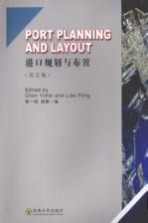

港口规划与布置 英文版教材PDF电子书下载
- 电子书积分:10 积分如何计算积分?
- 作 者:陈一梅,廖鹏编著
- 出 版 社:南京:东南大学出版社
- 出版年份:2009
- ISBN:9787564118969
- 页数:214 页
1 INTRODUCTION 1
1.1 The important role of modern ports 1
1.2 Port and its main components 2
1.3 Functions of modern ports 4
1.4 Classification of Ports 4
1.5 General information on port development 6
2 PORT OPERATION AND SHIPS 9
2.1 Cargoes 9
2.1.1 Classification of cargoes 9
2.1.2 Workings of cargoes inside the ports 11
2 2 Port hinterland and port throughput 12
2.2.1 Port hinterland and foreland 12
2.2.2 Port throughput 15
2 3 Forecast of port throughput 18
2.3.1 Introduction 18
2.3.2 Delphi Forecasting 20
2.3.3 Time series forecasting 22
2.3.4 Grey Prediction 25
2.4 Ships 27
2.4.1 Introduction 27
2.4.2 Shipboard measurement 28
2.4.3 Ship types 30
2.4.4 The development of maritime ship 36
2.4.5 Shipping services and networks 38
3 INVESTIGATION AND ANALYSIS FOR PORT PLANNING 40
3.1 Meteorological conditions 40
3.1.1 Wind 40
3.1.2 Rain and Fog 42
3.1.3 Ice 43
3.2 Oceanographic conditions 44
3.2.1 Tide 44
3.2.2 Waves 45
3.2.3 Currents 49
3.3 Estuary conditions 51
4 TERMINAL AND LAYOUT OF QUAYSIDE 53
4.1 Classification of terminals 53
4.1.1 By the function 53
4.1.2 By the layout 54
4.2 Scale of terminals 57
4.3 Determination of the optimum berth number 62
4.3.1 The calculation of optimum berth number 63
4.3.2 The application of queuing theory 64
4.4 Some suggestions for port operation management 70
4.4.1 Berth group 70
4.4.2 Handling productivity 71
4.4.3 The timing for increasing port capacity 72
4.5 Determination of berth scale 73
4.6 Typical layout for general cargo terminal 74
4.7 Typical layout for container terminal 77
4.7.1 Layout for container terminal water area 77
4.7.2 Layout for container terminal land area 78
4.8 Typical layout for dry bulk terminal 84
4.9 Typical layout for Ro/Ro berth 87
4.10 Typical layout for oil terminal 92
4.11 Typical layout for LPG/LNG terminal 94
4.12 Determination of berth surface elevation 97
5 HARBOR AND BREAKWATER 99
5.1 Introduction 99
5.2 Water depth 99
5.2.1 Components of water depth clearance and determinants 100
5.2.2 Water depth in berthing area 102
5.2.3 Water depth in approach channel 103
5.3 Channels 104
5.3.1 Channel Alignment 104
5.3.2 Channel width 105
5.4 Anchorage area and turning area 107
5.5 Standards for harbor tranquility 108
5.6 Layout of breakwater 110
5.7 Aids to navigation 113
6 LANDSIDE FACILITIES 114
6.1 Port railway 114
6.2 Road 118
6.3 Other facilities of port 120
7 PORT DEVELOPMENT PLANNING 124
7.1 Port planning process 124
7.1.1 Primary planning 124
7.1.2 The port distribution planning 126
7.1.3 The general port planning 126
7.1.4 The port area planning 127
7.2 Port demand forecasting 128
7.3 Port site selection 132
7.3.1 The port location 132
7.3.2 The basic types of the port arrangement 133
7.3.3 The basic requirement for the port site selection 135
7.3.4 The port area and the urban area 136
7.4 Port zoning 138
7.4.1 Port zoning strategy 139
7.4.2 Port zoning procedure 141
7.5 Port financial evaluation 142
8 PORT ENVIRONMENT ASSESSMENT AND PROTECTION 147
8.1 General introduction 147
8.2 Port environmental impact assessment 148
8.2.1 EIA of port construction projects 148
8.2.2 Environmental impact assessment of port planning 150
8.3 Environmental protection of domain coast 152
8.3.1 Domain coast environmental protection 152
8.3.2 Ecological environment protection 154
9 CHARACTERISTICS OF INLAND RIVER PORTS 156
9.1 Introduction 156
9.2 Site selection 157
9.3 Terminals facilities 161
9.4 Layout of Inland River Port 165
9.4.1 Terminal surface and bottom elevation 166
9.4.2 Layout of the berth line 167
Appendix A Introduction to EDI 169
Appendix B A Note on Queuing Theory 176
Appendix C Logistics and Route Selection 184
Appendix D Vessel Arrival and Berthing Time Distribution 189
Appendix E National Plan for Coastal Port 192
Appendix F Port of New York and New Jersey 198
Appendix G Special Economic Zone,Free Trade Zone and Free Port 204
References 213
- 《全国高等中医药行业“十三五”创新教材 中医药学概论》翟华强 2019
- 《MBA大师.2020年MBAMPAMPAcc管理类联考专用辅导教材 数学考点精讲》(中国)董璞 2019
- 《党员干部理论学习培训教材 理论热点问题党员干部学习辅导》(中国)胡磊 2018
- 《“十三五”规划教材 中药鉴定学实验 供中药学 药学及相关专业使用 第2版》吴啟南 2018
- 《卓有成效的管理者 中英文双语版》(美)彼得·德鲁克许是祥译;那国毅审校 2019
- 《危险化学品经营单位主要负责人和安全生产管理人员安全培训教材》李隆庭,徐一星主编 2012
- 《21世纪法学系列教材 配套辅导用书 行政法与行政诉讼法练习题集 第5版》李元起主编 2018
- 《高校转型发展系列教材 素描基础与设计》施猛责任编辑;(中国)魏伏一,徐红 2019
- 《全国校外艺术课堂新形态示范教材系列 少儿钢琴表演曲集》唐冠祥编著 2019
- 《全国学前教育专业(新课程标准)“十三五”规划教材 简谱手风琴教程 第2版》(中国)杨克勤,王宝庆 2019
- 《市政工程基础》杨岚编著 2009
- 《家畜百宝 猪、牛、羊、鸡的综合利用》山西省商业厅组织技术处编著 1959
- 《《道德经》200句》崇贤书院编著 2018
- 《高级英语阅读与听说教程》刘秀梅编著 2019
- 《计算机网络与通信基础》谢雨飞,田启川编著 2019
- 《看图自学吉他弹唱教程》陈飞编著 2019
- 《法语词汇认知联想记忆法》刘莲编著 2020
- 《培智学校义务教育实验教科书教师教学用书 生活适应 二年级 上》人民教育出版社,课程教材研究所,特殊教育课程教材研究中心编著 2019
- 《国家社科基金项目申报规范 技巧与案例 第3版 2020》文传浩,夏宇编著 2019
- 《流体力学》张扬军,彭杰,诸葛伟林编著 2019
